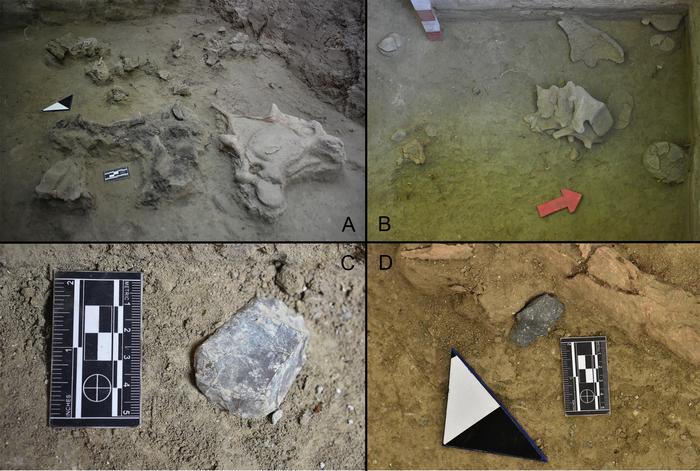Thousands of years ago, early hunter-gatherers returned regularly to Tagua Tagua Lake in Chile to hunt ancient elephants and take advantage of other local resources, according to a study published May 22, 2024 in the open-access journal PLOS ONE by Rafael Labarca of the Pontifical Catholic University of Chile and colleagues.

Credit: Labarca et al., 2024, PLOS ONE, CC-BY 4.0 (
Thousands of years ago, early hunter-gatherers returned regularly to Tagua Tagua Lake in Chile to hunt ancient elephants and take advantage of other local resources, according to a study published May 22, 2024 in the open-access journal PLOS ONE by Rafael Labarca of the Pontifical Catholic University of Chile and colleagues.
Multiple archaeological sites are known from the region of Tagua Tagua Lake in central Chile, representing some of the earliest known human settlements in the Americas. In this study, Labarca and colleagues report the recent discovery of a new site called Taguatagua 3, an ancient hunter-gatherer camp dating to the Late Pleistocene, between 12,440-12,550 years old.
Notably, this site features the fossil remains of a gomphothere, an extinct relative of elephants. Signs of butchery on the bones, along with stone tools and other evidence, indicate that Taguatagua 3 represents a temporary camp established around the task of processing the large carcass. Other activities were also carried out during the camp’s brief period of use, including processing of other foods as indicated by additional charred remains of plants and small animals such as frogs and birds. Fossil cactus seeds and bird eggshell suggest that this camp was occupied specifically during the dry season.
Numerous such sites of similar age are now known from this region, implying that Tagua Tagua Lake was a recurring hunting and scavenging ground for people during the Late Pleistocene due to abundant and predictable local resources. The authors suggest that this area was a key location along the routes taken by mobile communities of the time and that temporary camps might have hosted regular meetings between these mobile bands. Further investigation of this rich archaeological region will continue to provide insights into the mobility and subsistence strategies of early humans in South America.
The authors add: “Taguatagua 3 helps us to understand better how the early humans adapted to fast changing environments in central Chile during the late Pleistocene times.”
#####
In your coverage please use this URL to provide access to the freely available article in PLOS ONE:
Citation: Labarca R, Frugone-Álvarez M, Vilches L, Blanco JF, Peñaloza Á, Godoy-Aguirre C, et al. (2024) Taguatagua 3: A new late Pleistocene settlement in a highly suitable lacustrine habitat in central Chile (34°S). PLoS ONE 19(5): e0302465.
Author Countries: Chile, Argentina, Spain, UK
Funding: This research was funded by ANID-FONDECYT Grants 11170919, 11220930, 1230860, Fundación Palarq Grant 2020-2022 and the Ilustre Municipalidad de San Vicente. Additional support was provided by FONDEQUIP EQM150101 (SEM-EDX) and FONDEQUIP EQM150020 (Confocal microscopy/RAMAN/AFM spectroscopy). The funders had no role in study design, data collection and analysis, decision to publish, or preparation of the manuscript.
Journal
PLoS ONE
Method of Research
Observational study
Subject of Research
People
Article Title
Taguatagua 3: A new late Pleistocene settlement in a highly suitable lacustrine habitat in central Chile (34°S)
Article Publication Date
22-May-2024
COI Statement
The authors have declared that no competing interests exist.



